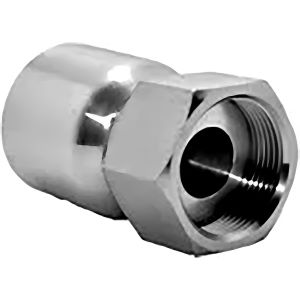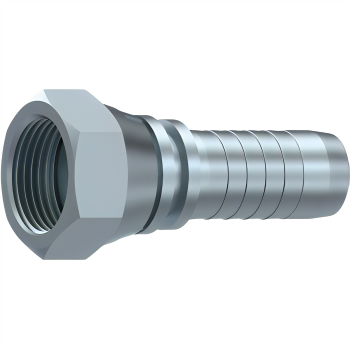In the world of hydraulic systems, the right fittings are crucial for optimal performance and efficiency. One such fitting that has gained popularity is the flat-face hydraulic hose fitting. This article explores the features, benefits, installation, and maintenance of flat-face hydraulic hose fittings, providing valuable insights for those seeking to enhance their hydraulic systems.
Understanding Flat-Face Hydraulic Hose Fittings
Flat Face hydraulic hose fittings, commonly referred to as O-ring Face Seal fittings or ORFS fittings, have demonstrated exceptional efficacy in eradicating leakage, particularly under elevated pressures prevalent in modern hydraulic systems. These fittings utilize a flat mating surface on both the male and female connectors, creating a tight seal when connected. The flat-face fittings are engineered to meet international standards, including, ISO 12151-1, ISO 8434-3, and SAE J1453-2, eliminating potential fluid leakage, making them highly reliable and efficient.
Benefits of Flat-Face Hydraulic Hose Fittings
✅ Leak-Free Connection
The primary advantage of flat-face hydraulic hose fittings is their ability to provide a secure and leak-free connection, preventing fluid loss and minimizing downtime.
✅ High Pressure Capability
These fittings are designed to withstand high-pressure hydraulic applications, ensuring optimal performance even in demanding conditions.
✅ Easy Connection and Disconnection
Flat-face fittings feature a quick-connect mechanism, allowing for easy and convenient installation and removal without the need for specialized tools.
✅ Minimal Fluid Contamination
The flat mating surface reduces the risk of dirt and debris entering the hydraulic system, maintaining the cleanliness of the fluid and prolonging the life of the system components.
Factors to Consider When Choosing Flat-Face Hydraulic Hose Fittings
When selecting flat-face hydraulic hose fittings, it's important to consider the following factors:
✅ Material Compatibility
Ensure that the fittings are made from materials compatible with the fluids and operating conditions of your hydraulic system to prevent corrosion and premature failure.
✅ Size and Thread Type
Select fittings that match the hose size and thread type of your hydraulic system to ensure a proper and secure fit.
✅ Pressure Rating
Consider the maximum operating pressure of your hydraulic system and choose fittings that can handle the desired pressure range.
✅ Environmental Conditions
Evaluate the temperature, humidity, and exposure to chemicals or external elements that the fittings will be subjected to, and select fittings that can withstand these conditions.
Installation and Maintenance of Flat-Face Hydraulic Hose Fittings
Proper installation and maintenance are essential for the longevity and performance of flat-face hydraulic hose fittings. Follow these guidelines:
1. Thoroughly clean and inspect the mating surfaces before connecting the fittings to ensure a clean and secure seal.
2. Use the appropriate torque specifications when tightening the fittings to prevent over-tightening or under-tightening, which can lead to leaks or fitting damage.
3. Regularly inspect the fittings for signs of wear, corrosion, or damage, and replace any components that show signs of degradation.
4. Follow manufacturer recommendations for maintenance intervals and fluid replacement to optimize the performance of your hydraulic system.
Common Applications of Flat-Face Hydraulic Hose Fittings
Flat-face hydraulic hose fittings find applications in various industries, including:
➢ Construction and Earthmoving Equipment
➢ Agricultural Machinery
➢ Mining and Quarrying Equipment
➢ Manufacturing and Industrial Machinery
➢ Forestry Equipment
➢ Material Handling Equipment
Troubleshooting and Maintenance Tips
➢ To ensure the smooth operation of your hydraulic system using flat-face hydraulic hose fittings, consider the following troubleshooting and maintenance tips:
➢ If you notice any leaks or fluid loss, immediately inspect the fittings and seals for damage or wear. Replace faulty components as necessary.
➢ Check for signs of contamination in the hydraulic fluid, such as discoloration or debris. Regularly change the hydraulic fluid and filters to maintain optimal system performance.
➢ Monitor the system pressure and temperature regularly to identify any abnormalities that may indicate a problem with the fittings or other system components.
➢ Educate operators and maintenance personnel on proper handling and maintenance procedures to prevent accidental damage or improper installation of fittings.
Conclusion
Flat-face hydraulic hose fittings offer numerous advantages, including leak-free connections, high-pressure capabilities, and ease of installation. By choosing the right fittings and following proper installation and maintenance procedures, you can ensure optimal performance and efficiency of your hydraulic system.
Regular inspections, troubleshooting, and adherence to manufacturer guidelines are vital for prolonging the lifespan of the fittings and avoiding costly downtime.
Frequently Asked Questions (FAQs)
Q1: Can I reuse flat-face hydraulic hose fittings?
A1: It is generally recommended to replace the seals when reusing flat-face hydraulic hose fittings to ensure a proper seal and prevent leaks.
Q2: How do I know if a flat-face hydraulic hose fitting is compatible with my system?
A2: Check the hose size, thread type, and pressure rating of the fitting to ensure compatibility with your hydraulic system's requirements.
Q3: What is the difference between flat-face and traditional hydraulic hose fittings?
A3: The main difference lies in the design of the mating surface. flat-face fittings provide a more secure and leak-free connection compared to traditional fittings.
Q4: Can I connect flat-face hydraulic hose fittings to other types of fittings?
A4: It is generally not recommended to connect flat-face fittings to other types of fittings, as it may compromise the integrity of the hydraulic system.
Q5: How often should I inspect and maintain flat-face hydraulic hose fittings?
A5: Regular inspections should be conducted as per the manufacturer's recommendations, and maintenance should be performed at specified intervals to ensure optimal performance and reliability.
Post time: Jul-20-2023



